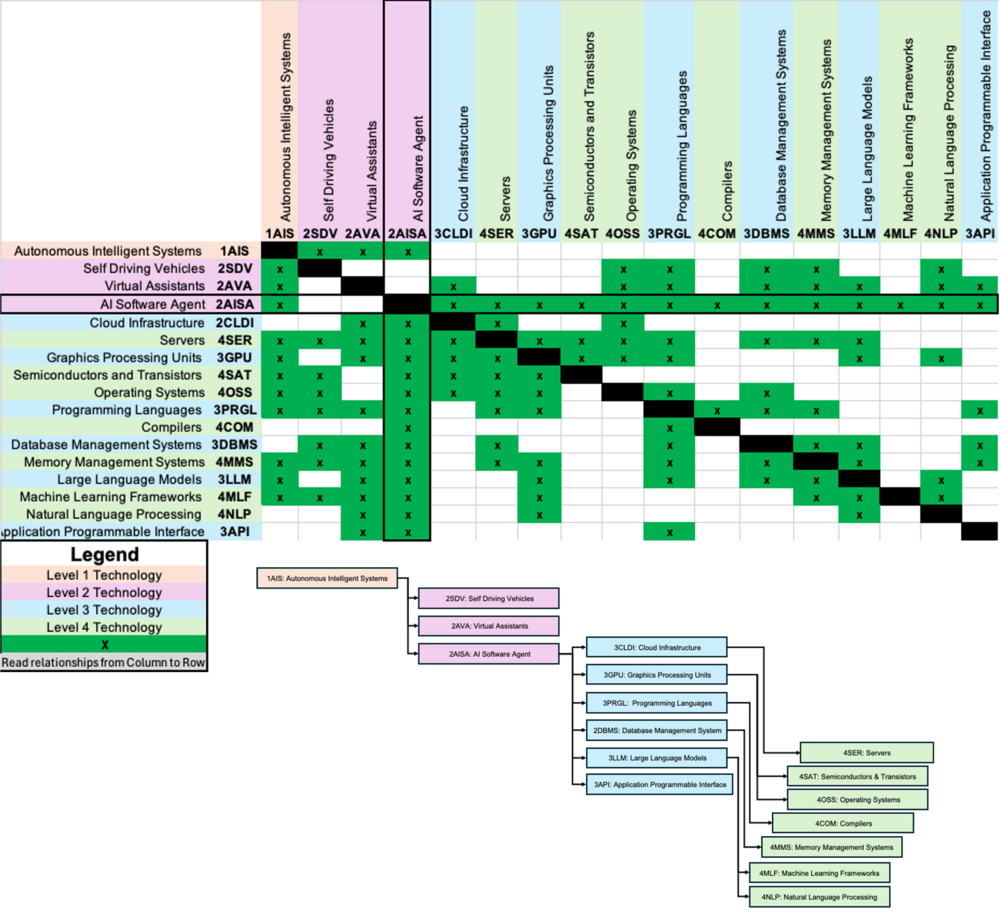Difference between revisions of "Artificial Intelligence Software Agent"
| Line 36: | Line 36: | ||
==Design Structure Matrix (DSM) Allocation== | ==Design Structure Matrix (DSM) Allocation== | ||
[[File:AI Agent DSM-Decomp.png|1000px|thumb|center|2AISA DSM & Relation to other Technologies]] | |||
==Roadmap Model using OPM== | ==Roadmap Model using OPM== | ||
Revision as of 03:33, 10 October 2024
Roadmap Creators
Artificial Intelligence (AI) Software Agent Roadmap
- 2AISA - Artificial Intelligence (AI) Software Agent
The technology we selected is an AI Software Agent capable of receiving natural language prompts, generating complex software development strategies, executing all programming tasks to build end-to-end software applications, and deploying those applications for business or leisure purposes. This is a Level 2 Technology Roadmap. Level 1 encapsulates the ecosystem of all AI System Technologies, while Levels 3 and 4 would include foundational technologies central to the form and function of AI, including but not limited to Machine Learning, Neural Networks, Large Language Models, and Graphics Processing Units (GPUs).
Roadmap Overview
Since ChatGPT-4 was released in 2022, it has amazed people worldwide and marked the beginning of a new era in AI innovation. The prosperity has expanded from hardware advancements like GPUs to breakthroughs in large language models (LLM), natural language processing (NLP), and machine learning (ML). This year, 2024, has been nominated the year of AI agents due to the rapid advancements in AI technologies, with emerging trends such as multi-agent systems and agentic AI. These agents are reshaping industries by automating processes, enhancing productivity, and enabling more multi-model interactions. Software AI agents are becoming increasingly sophisticated, offering new possibilities for automation, decision support, and human-AI collaboration across various domains.
AI agents possess several core capabilities:
- Perception: gather data and documents from database, APIs
- Reasoning: analyze data, identify patterns, and make informed decision using advanced algorithms and machine learning
- Action: autonomously perform tasks, from answering queries to executing complex processes
- Learning: continuously learn from experience and improve performance over time


According to the AI Benchmarking Report by CodeSignal, while AI agents are increasingly powerful, the creativity and intuition of human engineers demonstrate when dealing with complex or cutting-edge problems still marks a weakness of AI agents. This technology roadmap explores the potential of AI software agent in automation, decision making, and human-AI collaborations.
Reference:
- https://www.leewayhertz.com/ai-agents/
- https://yellow.ai/blog/ai-agents/
- https://codesignal.com/blog/engineering/ai-coding-benchmark-with-human-comparison/
Design Structure Matrix (DSM) Allocation
Roadmap Model using OPM
The Object-Process-Model (OPM) of the 2AISA AI Software Agent is provided in the figure below. This diagram captures the main object of the roadmap, its various processes and instrument objects, and its characterization of two relevant Figures of Merit (FOMs): Productivity and Accuracy.


